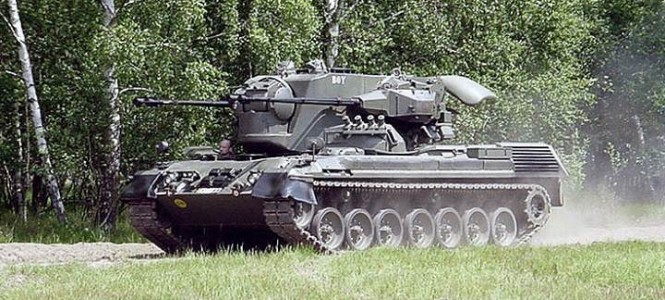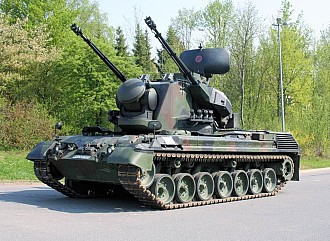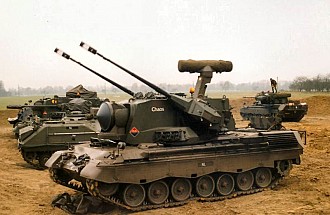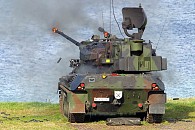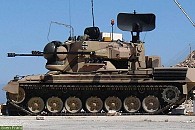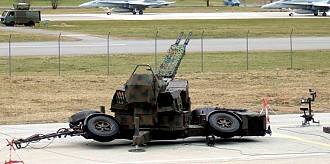Air defense / Self-propelled anti-aircraft guns / Gepard
Gepard
General Facts
- TYPE
Self-propelled anti-aircraft gun - ORIGIN
 Germany
Germany - NICKNAMES
5PFZ-B2 (development name)
Flakpanzer Gepard (official German name)
Pantser Rups Tegen Luchtdoelen / PRTL (Dutch service)
Cheetah / CA 1 (Dutch service)
Pruttel (Dutch nickname) - DESIGNED
1965 - 1973 - DESIGNER
Rheinmetall, Kraus-Maffei, AEG-Telefunken - PRODUCTION
1976 - 1980 - PRODUCERS
 Germany - Kraus-Maffei Wegmann
Germany - Kraus-Maffei Wegmann - QUANTITY
570 plus 19 pre production vehicles - UNIT COST
DM 2.85 million in 1973 - CHARACTERISTICS
 Very powerful armament
Very powerful armament
 High quality radar system
High quality radar system
 Good all terrain mobility
Good all terrain mobility
 Well armored
Well armored
 Large and heavy
Large and heavy
 Very expensive
Very expensive
Introduction
The Gepard is a late Cold War era self-propelled anti-aircraft gun of German origin. It was developed in the late 1960's in response to the increased Soviet frontal aviation threat, including the well armored Mi-24 Hind attack helicopter. The Gepard is a very capable anti-aircraft gun with enormous firepower and good fire control equipment. The name Gepard is German for Cheetah.
Layout
The Gepard is based on the Leopard 1 chassis, which is lengthened and has less armor. The driver is seated at the front, the two man turret in the middle and the engine and drivetrain at the rear. The turret is unusual since the two 35mm autocannon are mounted on each side of the turret. The search radar is mounted on top of the turret at the rear and the tracking radar is mounted in front of the turret. When on the move the search radar is lowered behind the turret and tracking radar rotates 180 degrees.
Firepower
The Gepard is armed with two 35mm Oerlikon KDA autocannon, making it one of the most powerful self-propelled anti-aircraft guns in existence. Each gun fires at 550 rpm and is supplied with 320 HE rounds plus 20 AP rounds for use against ground targets. The effective AA range is 3.5 km with standard rounds and up to 4.5 km with FAPDS rounds. In a normal engagement 20 to 40 rounds are fired at a single target.
Fire control
The Gepard is fitted with a S-band search radar at the rear of the turret and a Ku-band Doppler tracking radar fitted at the front of the turret. Both have a range of 15 km. Some vehicles also have a laser range finder. The Dutch vehicles have Philips radars and can be idenfied by the bar shaped search radar instead of the trough shaped radar on the original vehicles. The Dutch radars allow for higher resolution images. The X-band Doppler search radar has a 15 km range and the X-band monopulse tracking radar 13 km.
Protection
The Gepard is protected by steel armor on the hull and turret. The hull armor is slightly thinner than on the Leopard 1, but the Gepard is still protected from 14.5mm rounds, small arms fire and shell splinters. The Gepard is operated under full armor protection and an NBC system and smoke grenade dischargers are fitted.
Mobility
Since the Gepard is based on the Leopard 1 chassis it posesses a good cross country mobility and it can keep up with the armored forces it is designed to protect. The chassis is fitted with the same MTU 830 hp diesel as used in the Leopard 1. An APU powers the systems when the engine is not running.
Users
The Gepard was adopted by Germany, Belgium and the Netherlands. Due to the high costs the Gepard did not see any export sales, the Gepard about three times more expensive than a Leopard 1 tank. In all three nations it has been replaced by short range surface to air missiles such as the Stinger. Obsolete units have been sold to Romania and Chile.
Gepard
The Gepard is a large and powerful self-propelled anti-aircraft gun based on the Leopard 1 chassis.
Gepard 1: Original serial production model. A total of 214 built for Germany and 55 for Belgium.
Gepard 1A1: Improved model with laser range finder. A total of 206 were produced new.
Gepard 1A2: Extensive refit for service until 2015 and final improvement with ability to fire FAPDS-T rounds. A total of 147 vehicles refitted.
- Specifications:
- Gepard
| Type | Self-propelled anti-aircraft gun |
|---|---|
| Crew | 3 (commander, driver, gunner) |
| Length | 6.85 m hull, 7.73 m guns forward |
| Width | 3.37 m |
| Height | 3.29 radar down, 4.03 m radar up |
| Ground clearance | 0.44 m |
| Weight | 44.8 t empty, 47.3 t combat load |
| Ground pressure | 0.95 kg/cm2 |
| Wheelbase | Tracked chassis, 7 roadwheels, idler front, sprocket rear, 2.7 m track, 0.55 m width |
| Turn radius | ? |
| Engine | MTU MB 838 Ca M500 10-cylinder multifuel diesel, 830 hp at 2.200 rpm |
| Power ratio | 17.5 hp/t |
|---|---|
| Transmission | 4 forward, 2 reverse |
| Speed | 65 km/h |
| Fuel | 985 L |
| Range | 550 km on road, 400 km cross country |
| Wall | 1.15 m |
| Trench | 3 m |
| Gradient | 60% gradient |
| Fording | 2.5 m |
| Armor | Steel, up to 70 mm |
| NBC equipment | Yes |
| Night vision | Yes |
|---|---|
| Smoke | 2x4 76mm smoke grenade dischargers |
| Remarks | 15 km search radar, 15 km tracking radar |
| Armament | 2x 35mm KDA autocannon |
| Weapon1 | 2x 35mm Oerlikon KDA L/90 autocannon 640 HE, 40 AP, all ready to fire -10 to +85° elevation, 45°/s powered 360° traverse, 90°/s powered |
| Weapon2 | - |
| Weapon3 | - |
| Weapon4 | - |
| Weapon5 | - |
| Weapon6 | - |
Cheetah
Cheetah: The Cheetah is the Dutch version of the Gepard. Originally it was called the CA1 but the nickname Cheetah painted on the first operational CA1 stuck. It differs in radar suite and other minor details. The Dutch version has a more capable and expensive radar suite. It can be identified by its bar type search radar and more pointed tracking radar. Most Cheetahs were upgraded with the ability to fire FAPDS-T rounds.

